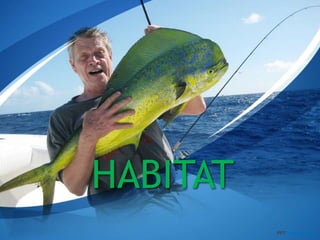HABITAT.pptx
The document discusses different types of habitats including aquatic, terrestrial, and arboreal habitats. It provides examples of organisms found in each habitat and describes their adaptations. Aquatic habitats include freshwater, marine, and estuarine environments inhabited by organisms like whales, turtles, and water plants. Terrestrial habitats refer to land environments where organisms such as humans, domestic animals, and wild animals live. Arboreal habitats refer to life in or on trees and are home to animals like parrots and monkeys. The document then discusses examples of adaptations that allow organisms to survive in their habitats, such as gills and fins in aquatic organisms, extensive root systems in terrestrial plants, and wings in arboreal birds and bats.

Recommended
Recommended
More Related Content
Similar to HABITAT.pptx
Similar to HABITAT.pptx (20)
Recently uploaded
Recently uploaded (20)
HABITAT.pptx
- 1. HABITAT
- 2. Habitat is a place or environment where organisms normally live. There are three major types of habitat. These are : Aquatic terrestrial arboreal habitats.
- 3. Aquatic Habitat: (i) Freshwater (ii) Marine (iii) Estuarine Living organisms found living in aquatic habitat include whale, turtles, water lettuce, water lilies etc. Aquatic habitats are classified according to their salinity (salt content).
- 4. Terrestrial Habitat: • Then terrestrial habitat refers to land environment. Living organisms found living in terrestrial habitat include man, domestic animals e.g. dog, cat, goat, wild animals such as lion, tiger etc. Terrestrial habitats can be; • (i) Tropical rainforest • (ii) Savannah (grassland) • (iii)Desert
- 5. Arboreal Habitat: Arboreal habitat means air environment. It can also be referred to as life in or on trees habitat. Animals like parrots, weaver birds, monkeys and orangutans are good examples of animals found in arboreal habitats.
- 6. ADAPTATION OF ORGANISMS TO THEIR HABITATS Plants and animals are found in a particular area (habitat) because they have special features which help them to survive in that habitat. Adaptation is any feature of an organism in structure or activity that makes the organism to survive in its environment. Such features are called adaptive features. For instance, fishes have gills, fins and tails (adaptive features) water bodies.
- 7. ADAPTATION OF PLANTS TO AQUATIC HABITAT; (i) They have poorly developed root system. (ii) Generally, leaves of aquatic plants have large air spaces that keep them buoyant and let them absorb oxygen. (iii) Some possess breathing roots for gaseous exchange. (iv) Some possess waxy cuticles on their leaves to prevent wetting so that gaseous exchange can easily take place. Plants which grow only in or on water are known as hydrophytes e.g. Water lettuce, Water Lily.
- 8. ADAPTATION OF PLANTS TO TERRESTRIAL HABITAT; (i) They possess extensive root system for anchorage and water absorption e.g. Mahogany. (ii) Desert plants possess tiny and scanty leaves to reduce water loss through transpiration. (iii) Some have leaves reduced to spines e.g. Cactus, to reduce the rate of transpiration. (iv) They possess thick bark on their stems to protect internal tissues. (v) Some have special storage tissues that enable them to withstand conditions of external drought by using their water storage. E.g. Cactus.
- 9. ADAPTATION OF ANIMALS TO THEIR HABITATS Habitats Adaptation Living Organisms Aquatic Fins and tails for swimming, streamlined body for swimming. Fish, Toad, Tadpoles Webbed feet for swimming. Duck, Toads, Crocodile, Frog etc. Gills for breathing. Fish, Tadpoles Terrestrial Limbs, legs, arms, feet for walking, running and jumping, lung for breathing Man, Dog, Cow, Rat, lion etc Scaly skin to reduce water loss. Lizard Arboreal Wings for flight. Birds, Bat, Insects etc.
- 10. Slide Title Product A • Feature 1 • Feature 2 • Feature 3 Product B • Feature 1 • Feature 2 • Feature 3
- 11. Did you know? When you finish your PowerPoint presentation, you can upload it to: SlideOnline.com Congratulations You can use this free PowerPoint template for your own presentations. Follow us on Twitter @ppttemplatenet PPTTemplate.net Download More Free PowerPoint Templates And now what? You can safely delete this slide, but please consider to read below: